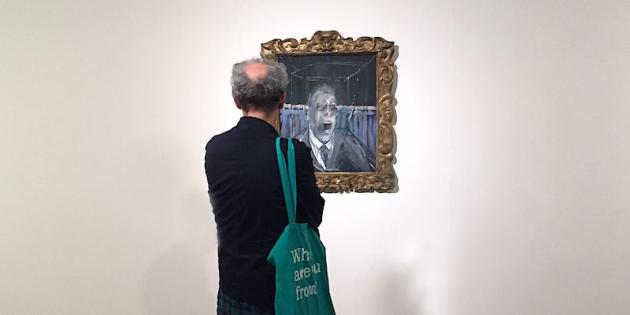The person who rode herd on Frances Bacon during the time that he was represented by the Marlborough Gallery – insofar, that is to say, as anyone could, in fact, ride herd on that raffish old queen – was an upright (some say uptight) lady called Valerie Beston. Since her death, there has been a trust founded in her memory that offers an annual prize to a “post graduating” student from the Royal College of Art. The prize, so the trust’s web-site tells one, “currently consists of studio space for one year, a monetary contribution towards materials and an exhibition for the artist concerned to show their work, at the end of the year.”
The show for the most recent prize-winner, David Cyrus Smith, is briefly on now, at the time of writing,until September 6th, followed by another show, from September 9th to 19th, that features work by all the artists who have received the prize during the first ten years of its existence.
Those most involved in making the choice is Pilar Ordovas, a former deputy chairman at Christie’s and the very much up-market dealer responsible for sorting out Miss Beston’s estate after her death in 2005, and Catherine Lampert, formerly director of the Whitechapel Art Gallery, and curator of the Frank Auerbach retrospective seen recently at Tate Britain. Both can be described, if only in purely art world terms, in the phrase once applied to Sarah Bernhardt, when she took the leading role Edmond Rostand’s drama L’Aiglon – they are très, très grande dame.
As the catalogue issued by Marlborough Gallery for this tenth-anniversary event is at pains to emphasize, these two leading specialists in contemporary art have throughout been very much of one mind, with no hint of any disagreement about the artists chosen.
Which seems weird, when one notes how very different the artists are from one another stylistically, and how up and down (to my eye at least) they are in quality. None of them absolutely stands out as totally surprising and original. Stylistically they run the gamut from solidly classical realism, to what look like attempts to go one better than Rothko.
One notes other peculiarities as well. Eight of the ten prize winners were born in the 1970s – three in the first half of the decade. They are in their forties: not really young by most definitions of that term. None seems to have achieved a stable relationship with a major dealer – certainly not with Marlborough. If the competition was intended to provide some new blood to that now venerable firm, it hasn’t done so. References to acquisitions by major public collections are pretty much absent.
None of this is the artists’ fault. What the show does is to provide a map of how fiercely competitive the world of contemporary art is now, and how hard it is to make an impact there, even with a bit of establishment help.
Most of all it demonstrates the total lack of any forward direction, the lack of any consensus about the way art – painting in this case – is going or ought to go.
If two très, très grande dames can’t tell in which direction we ought to look, there’s not much hope for the rest of us.
Words: Edward Lucie-Smith Photo: P C Robinson © Artlyst 2016

